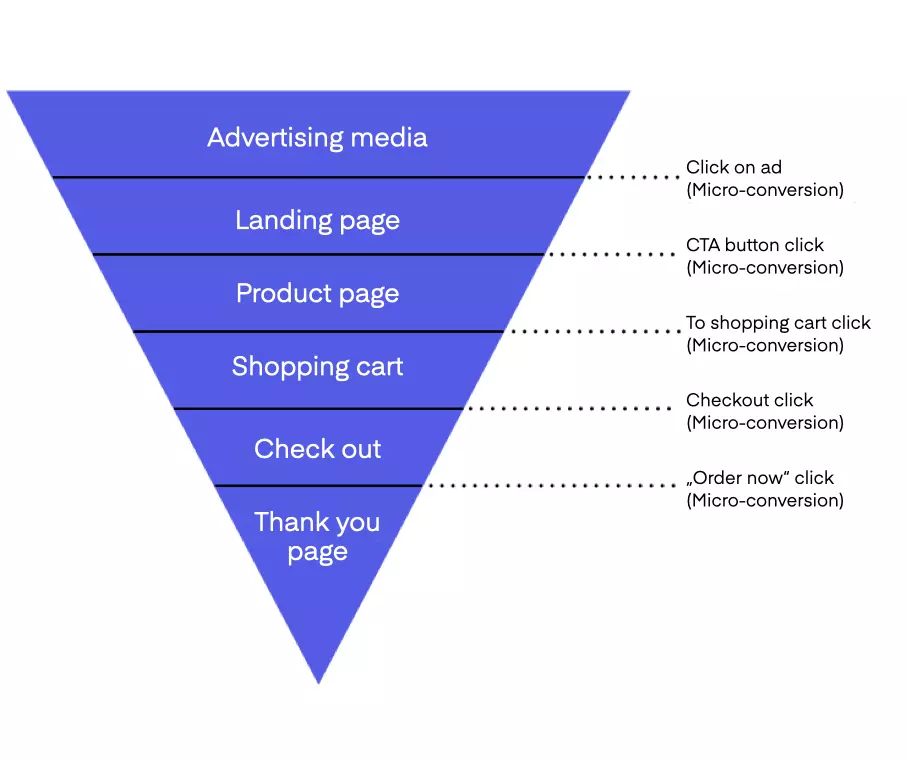Landing page basics
Landing page optimization (LPO for short) is a sub-area of conversion rate optimization (CRO), the aim of which is to increase conversions at all touchpoints. Micro and macro conversion rates must be consistently optimized at all levels of the conversion funnel. This ensures that the highest possible percentage of users reach the final stage of the funnel and convert to customers. As a subordinate special form of CRO, landing page optimization is specifically aimed at increasing the conversion rate of landing pages.

Landing pages are the entry pages for users. They therefore describe the page of a website to which users are redirected after clicking on a search result, advertising medium or link in an email. Landing pages are therefore to a certain extent the gateway through which the user reaches the website and therefore the first point of contact between the interested party and the provider's website. They therefore act as a link between access to a website and the desired conversion and aim to pick up the user and prepare for the actual conversion. The conversion goals of landing pages can vary depending on the website and business model. Common goals are:
Deeper access to the website
The user's conversion consists of deciding on a product category or product and being redirected to a page downstream in the funnel.Lead generation
The aim of the landing page is to obtain the user's email address (and other relevant information). This is often done by registering for a free offer, a newsletter subscription or a download.Contact
The landing page conversion here can be, for example, filling out a form or making a call (subcategory of lead generation).Product sales or contract conclusions
With sales-oriented landing pages, the aim is to encourage users to buy the product directly. Users are either redirected to a product page or the purchase option is offered directly on the landing page.
The requirements for good landing pages are of course very high, because just like offline, first impressions count. Imagine you enter a retail store. You immediately notice that it is very messy and confusing. You probably turn around immediately, leave the store and go on to the next one without even really looking around. It's the same with landing pages. As they convey the first impression of the website, it is important to give the user a positive feeling straight away. To ensure this, the aim must be to make the landing pages visually appealing, clear and easy to use and to convince users with strong content. To cover all points, landing page optimization can be divided into three subcategories:
- Content optimization
The aim of this sub-category is the optimal design of content. Clear calls to action, texts with persuasive potential, suitable product descriptions or the targeted use of different media formats have a significant influence on users and their decisions to take action. Good content is therefore a strong conversion driver and part of a holistic optimization process. Usability optimization
The aim is to improve usability and user-friendliness and thus remove obstacles that stand in the way of the user achieving their goal. Functional, clear and self-explanatory websites help users to find their way around and search for information. There is potential for optimization in the area of usability, for example in the page structure/navigation and loading times.Layout optimization/ design optimization
The optimization of visual appearance also plays an important role in CRO. Clear and appealing websites suggest professionalism to the viewer. This sub-discipline overlaps with usability, but also incorporates findings from neuromarketing. Changing the colour of a call-to-action button, for example, does not improve usability, but can demonstrably increase the conversion rate as a result of design optimization.
Optimization process
Landing page optimization is a continuous process, not a one-off task. Theoretically, optimization can be discontinued as soon as the conversion rate has reached the desired target value. In practice, however, conversion rates can hardly be high enough, as they have a direct impact on sales. Far too often, enormous financial resources are used to generate landing page traffic, while very little effort is put into optimizing conversion rates. However, a simple calculation example is actually enough to illustrate why it is so important not to neglect landing page optimization.
Let's assume you spend 10,000 euros on Facebook ads that redirect traffic to a landing page. With this page, you are aiming to sell a product worth EUR 19.99. With a cost-per-click of 20 cents, you manage to redirect 50,000 users to your website with your ad. Your conversion rate without optimization is 2%. You therefore sell the product 1000 times and generate revenue of EUR 19,990. If you now manage to increase your conversion rate to 3.5%, this means a turnover of EUR 34,982. An increase in turnover of EUR 14,992 should definitely be worth your time and effort, especially because the traffic has already been paid for and no other resources need to be used apart from your time.

Start with the "best-educated-guess", which is the first raw version of your landing page that you put online and optimize as you go along. A good landing page should not be built purely based on gut feeling. There are numerous studies that deal with the optimal structure of landing pages. You should not disregard previous research findings and follow best practices. Chapter 2.3 - Landing page blueprint explains exactly how a well thought-out and high-converting landing page should be structured.
Once the basic framework is in place and your first version is set up to the best of your knowledge and belief, you can get started. Now think about where possible optimizations could be useful. You should observe and analyze user behavior in order to not only act based on considerations, but to align landing page optimizations with the user. Whether you use web analysis tools, heatmaps or direct user tests is of secondary importance, but a combination of all methods is of course highly recommended. It is simply important that your sample is large enough to gain insights from your observations and identify optimization potential.
Now make your first change and create a second, optimized version of your landing page. You now test both versions in direct comparison with each other. In A/B testing, the traffic is randomized and distributed equally to both versions of the landing page. This gives you the opportunity to compare the results of the two variants and select the better one. If you are not using a multivariate testing tool, it is important that you only ever carry out one optimization per test in order to be able to attribute the results to a specific changed factor. You can find out more about A/B testing in Chapter 3 - A/B testing. Of course, you then decide on the landing page version with the higher conversion rate and continue with your optimizations. Now the next optimization measure is tested and the cycle starts all over again.
You can find out how to set up a landing page and which mistakes you should avoid in Part II.
